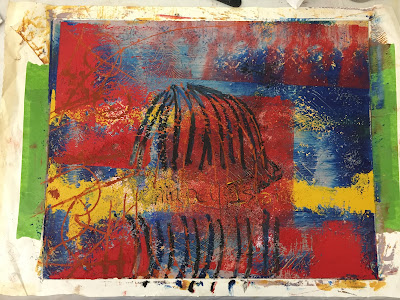Maquereau (French) = Mackerel
On Google Translate, there are definitions too
and it says the mackerel is:
"a migratory surface-dwelling predatory fish, commercially important as a food fish"
I do not know why
but I have been wanting to paint some mackerel
lying on a plate or a board. I don't even remember what it tastes like,
or if I have even ever had any! or why I wanted to paint some!
So I took a screenshot from the interwebs
of some mackerel (they happened to be in France),
and flipped them around and messed with the colors
and made my painting.
The following photos show my process.
 |
| Sketched in my mackerel with a thinned mix of burnt umber and ultramarine blue. |
 |
| Got a little more detail in, making sure ... |
 |
| Now some color, mostly a blue wash. |
 |
| I think there is a little bit of Pthalo blue in here at this point. |
 |
| Maquereaux pour votre dîner 12 x 10 inches oil on wood panel |
For your continuing fishy enjoyment,
I give you this beautiful painting of mackerel by Van Gogh 💕💕💕
... and a quote from Maria Popova, about a little book she found,
(writing at her wonderful Brain Pickings site),
about a boy and a fish ... and poems:
"Every once in a while, you stumble upon something so lovely, so unpretentiously beautiful and quietly profound, that you feel like the lungs of your soul have been pumped with a mighty gasp of Alpine air.
This Is a Poem That Heals Fish (public library) is a vitalizing gasp of loveliness — a lyrical picture-book that offers a playful and penetrating answer to the question of what a poem is and what it does. And as it does that, it shines a sidewise gleam on the larger question of what we most hunger for in life and how we give shape to those deepest longings.
Written by the French poet, novelist, and dramatist Jean-Pierre Simeón, and illustrated by Olivier Tallec, this poetic and philosophical tale follows young Arthur as he tries to salve his beloved red fish Leon’s affliction of boredom."
(I might need to find this book!)
Thank you so much for taking time to check in!
Happy fishing and happy painting!
Happy fishing and happy painting!




















